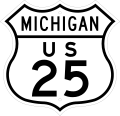Historic US-25
 On Page 1: Historical Overview
On Page 1: Historical Overview
On Page 2: Year-by-Year
History | Additional
Information
One of six mainline US Highways "decommissioned" in the state of Michigan, US-25 was originally designated as the US Highway to begin at Port Huron, head southwesterly through Detroit then southerly into Toledo, Ohio and then on through six other states to end on the Atlantic coast in Brunswick, Georgia. Later, US-25 was extended northerly from Port Huron to follow the Lake Huron shore to end at the "tip" of the Thumb.
Historical Overview
When the system of U.S. Highways was being laid out in the mid-1920s to provide a uniform system of signed routes across the country, one of these routes was designated to run between Toledo, Ohio and the western portion of Metropolitan Detroit. This route was eventually assigned the US-24 designation and exists, albeit in extended form, along that same route today.
However, the U.S. Highway system underwent a period of "tweaking" where routes were realigned, new designations added and several major changes were made. One of these later changes was the addition of an additional Toledo-Detroit route, this one into downtown Detroit instead of the western suburbs, then extending northeasterly via Mount Clemens to the International boundary at Port Huron and Sarnia, Ontario. This new Toledo-Port Huron route became an extension of US-25 running, previously, northerly from Georgia and ending in Toledo.
In Michigan, the 'new' US-25 routing used many existing roads, including Dixie Hwy in Monroe Co, Telegraph Rd in northern Monroe and southern Wayne Cos, and Gratiot Ave in eastern Wayne, Macomb and St. Clair Cos. The segment of US-25 from the intersection of West Rd & Telegraph Rd west of Trenton to the corner of Toledo Ave amp; Oakwood Blvd, however, was not yet complete and US-25 had to be routed concurrently with US-24 via Telegraph Rd northerly to Ecorse Rd, then easterly concurrently with M-17 via Ecorse Rd, Allen Rd and Oakwood Blvd. This gap was not completed until Toledo Hwy/Dix Hwy was opened to traffic around 1930.
After the realignment in 1930 noted earlier, the route of US-25 stayed relatively static for just three years until a major extension not quite doubled the length of the highway. In 1933, approval was sought and granted for an additional 85 miles to be added to the northern end of US-25, taking the terminus from Port Huron to Port Austin in Huron Co. The Port Huron-Port Austin route had been previously designated as part of M-29. As to why the State Highway Department sought to have US-25 extended to the "tip of the Thumb," that is not clear at present. Also, it is important to note, from 1933 to 1973, US-25 never existed west of Port Austin and never was extended to or planned to be extended to Bay City, however some Thumb-based civic organizations did champion such an extension to state transportation officials, to no avail.
In the decades between 1926 and the coming of the Interstate highways in the late-1950s, much of the route of US-25 between Toledo and Port Huron was upgraded to four-lane or divided highway status in an attempt to keep up with the growing amount of traffic in the corridor. In the early 1950s, the Michigan State Highway Department actually began planning for a freeway to replace both US-25 and nearby US-24 between the Ohio state line and Downriver Detroit. Much of the Detroit-Toledo Expressway was being constructed or even opened to traffic (as US-24A) before the Interstate Highway Act was even signed into law in 1956!
During the late-1950s and through the 60s, two different Interstates were built in the US-25 corridor. From Toledo into Detroit, it was I-75, while I-94 joined the US-25 corridor in Detroit and followed it northeasterly into Port Huron. Unlike other U.S. Highways in Michigan which were moved onto their parallel Interstates, portions of US-25 remained on their traditional alignments even after nearby freeways had long opened to traffic. Specifically, US-25 from the Ohio state line northerly to Woodhaven and again from downtown Detroit to Chesterfield Township were never transferred onto a freeway alignment.
Even though 152 miles of US-25's approximately 200-mile length were not concurrently designated with a parallel Interstate, the Department of State Highways in conjunction with their counterpart in the state of Ohio worked to truncate US-25 back to a terminus at the Ohio/Kentucky state line on the Ohio River at Cincinnati. In Michigan, those portions of what had been designated US-25 which were not concurrently routed with other highways needed new trunkline designations. From the Ohio state line to north of Monroe, the Department of State Highways decided to revive the M-125 designation, playing off the "25" which had been in place there. From west of downtown Detroit northeasterly to Chesterfield Twp, one of several new single-digit trunkline designations—in this case M-3—was assigned to the former US-25 there. From Port Huron northerly to Port Austin at the tip of the Thumb, though, the choice was much easier. Since 1933, M-25 proceeded westerly from the northern terminus of US-25 at Port Austin. The Department of State Highways simply extended the M-25 designation southerly down the east side of the Thumb, replacing US-25 into Port Huron. Thus, the US-25 designation ceased to be in the State of Michigan as of the winter of 1974 when all of the route markers came down.
Today, US-25 still begins at the Ohio/Kentucky state line at Cincinnati and proceeds southerly through Kentucky, Tennessee, and the Carolinas, ending in Georgia on the Atlantic coast.
Continues on Page
2: Year-by-Year History & Additional Information

